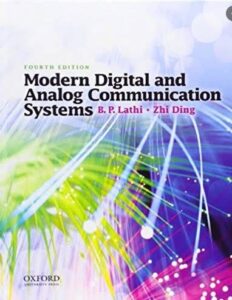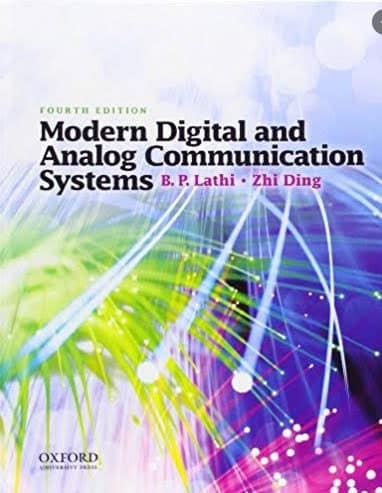Modern Digital And Analog Communication System 4th Edition (B. P. Lathi & Zhi Ding) With Full Book Download in PDF
As engineering students become increasingly aware of how integral communications systems play in modern life, they’re also increasingly inspired to find out about solid, illustrative real-life examples via experimentation with real-world analog communication systems. You can easily do so yourself by testing your knowledge using analog phones. In this brief article, we’ll examine a few real world examples of analog phones in use for instant messaging (texting) or other forms of hands-free communication. Let’s get cracking!

The digital telephone, often called a “hand-held” telephone, differs from a regular telephone in one significant respect: the operator functions of the handheld system are carried out by the electronic circuitry within the handset itself. The analog system on the other hand operates by means of a series of circuit boards. These boards may be constructed using a variety of materials – plastics, aluminum, metallic – and can be found in a wide range of colors and designs. The function of each board is only secondary to the aesthetic appearance of the entire handset. Additionally, the handsets of today contain built-in circuits which allow them to accept any type of SIM card. Theoretically, this allows for the possibility of communications when the cellular service is down, or if the user prefers to use a local telephone instead.
Today’s digital phone systems differ markedly from the original analog phones first produced and used during the last century. The modern analog phone, as the name implies, functions using a series of digits, or “digit,” for dialing a phone number. Digital telephone systems work much like an answering machine, wherein a caller is greeted by a pre-recorded message (or the soft sound of your voice) upon hitting the “enter” key on the keypad. In addition, modern digital telephone systems can be used as walkie-talkies (although they’re much less compact than their walkie-talkie predecessors). Another distinction between the analog phone and today’s digital phone systems is that the former requires a direct connection to a power source. Digital phone systems are also more likely to include a feature known as VoIP (Voice over Internet Protocol), which is used to transfer voice calls via the Internet.
Key to Object-Oriented Programming
Today’s analog phones still make use of telephone exchanges. When a person calls a line connected to a public switched telephone exchange (PSTN), that call is passed on through the same network of lines used by other callers. The analog phone systems can be separated into two different types: private, which are used within a private company or business; public, which are used by citizens and other public entities. Private phone systems often have local or unique lines. Public phone systems are connected to the public switch network. Some analog phone systems also connect directly to dedicated IP telephones, such as those used by the military.
One obvious difference between an analog phone and a digital one is the fact that the latter utilizes a different frequency band. Frequency band selection plays an important role in the operation of a digital phone system. Some digital phone companies use bands with wider bandwidth capacity and better signal transfer capabilities, such as the GSM (Global Standard Small Mobile Network) and CDMA (Code Division Multiple Access) standards.
With the recent introduction of VoIP (Voice over Internet Protocol), there is now the possibility for analog users to communicate with users with different locations using analog technology. This is particularly useful for rural and remote areas where regular telephone services are either unavailable or slow. VoIP uses a digital telephone adapter (known as a VoIP adapter) that allows users to make calls and receive calls from anywhere with an Internet connection, even though there is no direct connection to the local telephone exchange. The VoIP equipment only needs an Internet connection and a digital telephone.
Today, there is also the possibility for users to use digital phone systems that incorporate both analog and digital features. Digital phone lines can easily connect to an existing analog line in order to add voice messaging capabilities and allow for both conference and call transfer functions. A lot of digital phone systems have digital telephone ports that allow for various connectivity options, including standard RTP/RAS (Real Time Transport Protocol) and ISDN signaling. Digital phone systems can be used for business and professional applications, but they have also seen wide application in residential situations as well.
Another type of modern phone system is a virtual phone system, which does not require any hardware to connect to a conventional phone line. This technology allows you to “talk” to people around the world without having to pay a dime for long distance or multiple line charges. The technology works by allowing a user to make calls with another person via the Internet, regardless of whether the two people have a physical meeting or not. Digital voice enables the user to speak directly into a computer and to have that person answer the phone as if it were a traditional telephone. Many virtual phone services offer free voice message delivery and allow the user to control many aspects of their virtual voice communications, such as selecting the speed of their message delivery, how long it will last, and what kinds of features they want to receive.





